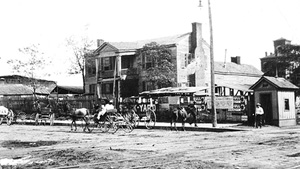From Proud Heritage, Volume II by DCPA. This hardcover book is available online.
William Baxter Bell was born in Collin County, in a rural community near what is presently known as Wylie, on 25 June 1884. He was the son of Baxter Manton Bell and Louisa Spurgin. His family relocated to Dallas County, west of the community of Duck Creek in 1870. William and his brothers and sisters attended Duck Creek school. There were two rooms and two teachers. The school was located north of the present site of the Garland Memorial Cemetery on South Garland Avenue.
At this time, there were a few stores and businesses along the banks of Duck Creek; the community of Embree was to the south. There were no fences, mostly unplowed prairie. There were wagon trails that served for roads and, if you rode a horse, you just “cut out” across the prairie.
By the time William had reached 15 years, he had lost both his parents and was living with his older sister and her family until he was on his own. After he was old enough to inherit the fifty-acre tract he had received from his father, he began farming. Shortly thereafter he married Mary Green Blankenship on 8 February 1885. Will and Mary attended the same school as children. She had, also, lost both parents and lived with an uncle, Joseph Strother, until she and Will married. They lived in a small house on their farm until, in 1887, the MK&T Railroad wanted to lay tracks across what is now Forest Lane. Will and Mary had to relocate their home because it was in the way of the tracks.
Ten children were born to Will and Mary, with eight living to raise families. Many of their offspring continue to live “in and around” the area. Two children died at an early age.
Both Will and Mary believed in discipline and shared in the children’s upbringing. Will was a rather quiet man, he never seemed to raise his voice; he just looked over his glasses, and the children knew it was time to settle down. They all had their share of the work, and, as on all farms, there was plenty to go around. Will added to his farm when he purchased 40 acres from Emily Strother. The land was on the comer of what is now Kingsley and Jupiter Roads.
After Mary’s death in 1934, one of Will’s sons and his family shared Will’s home. As he grew older, he sold his farms. The old “home place” was sold to an aircraft manufacturing company. The house where he and Mary had lived and raised their children was moved into Garland.
Will had a philosophy of not worrying about what you can’t change. He retained his sense of humor, even when ill health forced him to remain in bed much of his remaining years. He would recount for his grandchildren the vast changes he had seen during his lifetime and described the early ways of living. He spoke of the decline of the area farmland; the building and making way for progress. He talked of the last buffalo herd he observed grazing in the area where Memorial Hospital of Garland sits today; and how, at that time, large herds could still be seen west of Fort Worth.
He kept up with the”goings on” of the world by listening to his bedside radio. A staunch Democrat, he could give an argument about the good and bad points of the current administration. On the table, beside his radio, there always seemed to be a bag of lemon drops that were handed out to the great grandchildren.
He was a member of the First United Methodist Church in Garland. When he joined the church, it was a frame building, erected south of the cemetery. Later in 1904, the church was moved to its present site.
William lived until 20 March 1959, just five and one-half years short of a century. He and Mary rest in the Garland Memorial Cemetery.
By June LaRoe and Glenn Williams, Garland, TX


